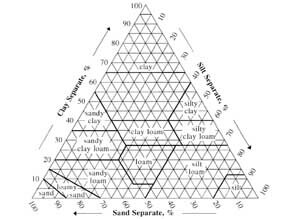Practical Note: Soil Texture
Download the PDF version of this document: Practical Note: Soil Texture (PDF 289KB).
To view the information PDF requires the use of a PDF reader. This can be installed for free from the Adobe website (external link).
Soil texture is the "feel" of the soil when a moist quantity is manipulated between thumb and forefinger. Some soils are sticky, others will not stick together at all, and others feel "doughy" or "spongey". Some soils can be manipulated like plasticine. These differences in properties gave rise, in agriculture, to soils being called clays, loams or sands. Clays stick to your boots, loams are easily moulded but non-sticky, sands are not cohesive at all and cannot be moulded when moist.
There are 19 grades of texture that can be simplified into six major groups: Sands, Sandy Loams, Loams, Clay Loams, Light Clays and Medium to Heavy Clays. These texture differences are the result of fineness or coarseness of particles in the soil. The particles are divided into three size classes:
Silt 0.002 - 0.02 mm Sand 0.02 - 2 mm Sand, silt and clay percentages are related together in a triangular graph. The graph shows groupings of soils and the name that is given to that grouping. So, silty soils always have more than 25 % of silt sized particles (organic material makes soils feel silky and therefore more silty). The loams all have less than 40 % clay sized particles. When moist soil is manipulated in the hand, sands, loams and clays feel very different (refer Quick Reference Guide – Assessing Soil Texture). The effect of particle size The relative size of particles is important. For example, the finest sand particles are 10 times the diameter of the largest clay particles. The surface area of a spherical particle 0.02 mm diameter is 100 times greater than a spherical particle of 0.002 mm diameter. Clays have an even greater surface area than spherical particles are they are made up of sheet-like structures stacked together. This difference in surface area contributes to the differences in adhesion and cohesion of the texture groups. |  Figure 1. Texture triangle |
How do sands, loams and clays behave?
Sands because of their large grain size allow faster permeability of water than clays. The disadvantages of sands are that they hold very little water that would be available to plants and have no ability to hold onto plant nutrients in the way that clays do.
Loam soils contain sand, silt and clay in such proportions that sticky-ness and non-adhesiveness are in balance - so the soils are mouldable but not sticky. Loams are the "friendliest" soils to cultivate.
Clays can absorb and hold onto large amounts of water because of their sheet structure and large surface area. This property causes the swelling and shrinking of clay soils as they wet and dry.
Clays are therefore also important in generating cracks in soil through which roots can easily pass. Of course, when clays are wet and swollen soil drainage is affected and water cannot pass freely. The surfaces and edges of the sheet structure of clay particles carry negative and positive charges. Elements such as Potassium, Calcium and Magnesium are held on these charged surfaces and can be taken up in solution by plant roots. Clays therefore play an important role in soil fertility.
What else effects soil texture?
How moist soil feels when manipulated in the hand is influenced by how much sand, silt or clay is in the sample, and also soil components such as organic matter.
Table 1. Influences on soil texture
| Medium and coarse sand | Easily felt |
| Fine sand | Felt and heard by manipulating the soil close to the ear |
| Silt | Silky or smooth feeling similar to that of talcum powder |
| Clay | Stocky, cohesive and plastic |
| Clay type | Clay mineralogy affects trafficability. Montmorillonite is very fine and encourages ribboning. Kaolinite is very coarse and will inhibit ribboning |
| Organic matter | Cohesion of sandy textures and greasiness of clays |
| Oxides | Cementation (Al & Fe) masks fine textures |
| Carbonates | Cohesion in sands and loams, but inhibits ribboning in clays |
Organic matter is an important contributor to soil texture and helps to ameliorate stickiness and also helps sandy soils hang together, making them feel more loamy.
How does texture change?
The texture of soil is considered to be a stable property. That is, changing the texture of your soil is possible but involves considerable mechanical and financial input. One example is clay delving, where clay from the subsoil is mixed with the sandy surface soil. Clay delving is used in the Mallee and much of Western Australia. For most land managers, changing the texture of the soil is not a viable option for soil management. Texture often changes with depth down the soil profile. It is important to describe texture changes that occur within the soil profile. Many of our soils have loamy surface soils and heavy clay subsoils. This arrangement controls the movement of water through the profile, the clay restricts downward drainage and encourages water movement along the top of the restricting layer. This can result in waterlogging of the surface soil, even though the subsoil may not be saturated.
Further information
For further information on the soils of your region visit Victorian Resources Online.


